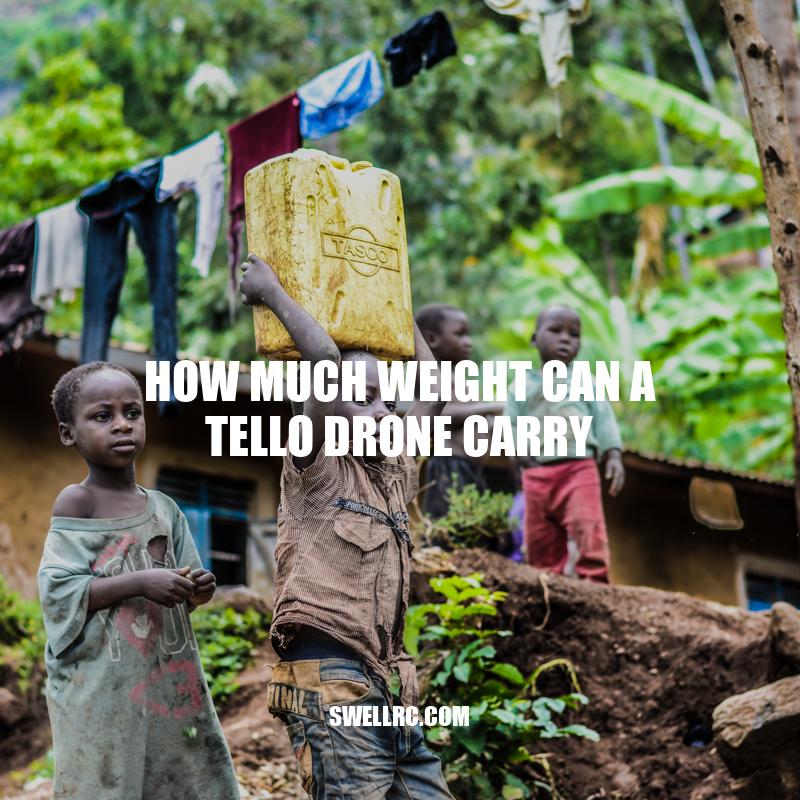Title: Tello Drone Weight Capacity: How Much Can it Carry?
Drones are becoming increasingly popular with enthusiasts, hobbyists, and professionals alike. These small, unmanned aircraft are known for their ability to capture stunning aerial footage, as well as their wide range of applications. The Tello drone is one of the most popular and affordable models on the market, known for its ease of use, impressive features, and lightweight design. One of the questions that often come up is how much weight can a Tello drone carry? Although the Tello drone is primarily designed for recreational use, it is still capable of performing many tasks, including carrying small payloads. Before attempting to mount anything on a Tello drone, it’s important to understand its weight carrying capacity to ensure safe and successful flights. In this article, we’ll explore how much weight a Tello drone can carry, how to determine its maximum load capacity, and some safety tips to keep in mind when carrying a load on your drone.
Understanding the Tello drone’s weight carrying capacity
Before attempting to mount anything on a Tello drone, it’s essential to understand how its weight carrying capacity works. Here are some factors that affect the weight carrying capacity of a Tello drone:
- Drone weight: The weight of the drone, including components and batteries, can impact the amount of weight it can carry.
- Motor power: The drone’s motor power plays a crucial role in its ability to lift and carry weight.
- Battery life: A drone with a more extended battery life is better suited for lifting loads as it can stay in the air for longer.
- Altitude: The higher the drone is flown, the lower its payload capacity will be, as the air is thinner at higher altitudes, reducing the drone’s lift capacity.
It’s essential to keep these factors in mind when calculating the Tello drone’s maximum payload capacity. Some websites provide useful resources to help determine the Tello drone’s maximum payload capacity, such as Tello Pilots’ weight test results and DJI store’s guide on maximum weight lifted by drones.
How do you calculate how much weight a drone can carry?
To calculate how much weight a drone can carry, follow these steps:
- Find the drone’s total thrust output by adding up the thrust of all its motors.
- Divide the total thrust by the drone’s weight to get the thrust-to-weight ratio.
- Multiply the thrust-to-weight ratio by the weight you want the drone to carry, ignoring the weight of the drone itself.
Note that weather conditions, such as wind, can affect a drone’s weight capacity. Always check the manufacturer’s specifications and follow local laws and regulations when flying drones.
Some drones may have specific weight restrictions or guidelines, so it’s important to refer to the manufacturer’s website for specific information on their products.
How to determine the weight that a Tello drone can carry
To determine the weight that a Tello drone can carry, you’ll need to know its maximum takeoff weight (MTOW), which is the combined weight of the drone and its components, and its thrust-to-weight ratio, which indicates its lifting capacity. Here are the steps to follow:
- Weigh the drone – Use a digital scale to weigh the drone and note down its weight.
- Calculate the MTOW – Check the Tello drone’s specifications sheet and sum up the weights of all its components, including the battery and any mounted payloads, to determine the drone’s MTOW.
- Calculate the thrust-to-weight ratio – Divide the drone’s thrust (expressed in Newtons) by its weight (in kilograms) to calculate the thrust-to-weight ratio.
Based on the calculated thrust-to-weight ratio, you can use the table below to determine the maximum weight that a Tello drone can carry.
| Thrust-to-weight ratio | Maximum payload capacity |
|---|---|
| 0.5 or less | Unsafe to fly |
| 0.5 – 1.0 | Up to 50 grams |
| 1.0 – 2.0 | Up to 70 grams |
| 2.0 – 3.0 | Up to 100 grams |
It’s important to note that exceeding a Tello drone’s weight carrying capacity can cause the drone to become unstable, and eventually crash. Therefore, it’s essential to adhere to the manufacturer’s recommended weight limits and always fly the drone within the given capacity.
How much weight a drone can lift?
Drones can lift different amounts of weight, depending on the size and design of the drone. Here are some typical weight lifting capacities of drones:
- Small drones: 0.25 to 2 kg
- Medium drones: 2 to 15 kg
- Large drones: over 15 kg
However, it is important to note that lifting capacity can also depend on various factors like the motor power, battery life, and additional weight of accessories or cameras.
If you are interested in purchasing a drone for lifting heavier weights, make sure to do thorough research and check the manufacturer’s specifications. Some popular drone models with high lifting capacities include DJI Matrice 600, Freefly Alta 6, and Spreading Wings S1000+.
Note: This information is based on general trends and may vary based on the drone model and other factors. For more specific information, please consult the manufacturer’s website or product manual.
What you can mount on a Tello drone
The Tello drone is a compact and lightweight drone designed primarily for recreational use. Although it can carry some weight, there are limits to what can be safely mounted on the drone. Here are some suggestions for what can be safely mounted on a Tello drone:
- Small cameras or action cameras like GoPro, Osmo Action or Insta360 Go. You can use a 3D printed mount to attach these cameras to the drone.
- LED lights for night-time flying to enhance visibility and add to the fun factor.
- Small toys, like legos, to transport small objects or engage in aerial games.
- A foam ball, attached to the drone’s landing gear, for playing catch with the drone.
It’s important to note that anything mounted on the drone will affect its weight and balance. Therefore, it’s essential to stay within the recommended weight limits and use only approved mounting hardware on the drone. Additionally, any payload mounted on the drone should be balanced to ensure smooth and stable flight. Happy flying!
Is DJI Tello a toy drone?
- Yes, DJI Tello is classified as a toy drone because of its small size, lightweight and affordable price point compared to other professional drones.
- However, DJI Tello is not your average toy drone as it comes with advanced flight technology, a high-quality camera, and programmable features that allow you to create custom flight paths and animations.
- The DJI Tello has a maximum flight time of 13 minutes, a 720p camera, and can fly up to 100 meters away from the controller.
- The DJI Tello is a great option for beginners and kids who want to explore the world of drones without breaking the bank.
Safety precautions to take when carrying load
When carrying a load on a Tello drone, it’s important to take some safety precautions to ensure that you and others stay safe. Here are some tips to consider:
- Always weigh the drone before attempting to mount anything on it, and make sure that the total weight of the drone, its components, and the load does not exceed the maximum weight limit.
- Make sure the load is secured properly and balanced to avoid any instability or accidents during flight. Use approved mounting hardware to secure the load to the drone.
- Don’t fly the drone in high winds or bad weather, as this can affect the stability and control of the drone, especially when carrying a load.
- Avoid exceeding the maximum load limit, as this can cause the drone to become unstable and crash during flight.
By taking these safety precautions, you can ensure that your Tello drone remains stable and steady during flight, even when carrying a load. Happy flying!
Note: You can purchase a Tello Drone from DJI’s official website.
How much weight can a Tello drone carry?
The Tello drone has a weight limit of just 80 grams, which includes both the weight of the payload and any additional accessories. It is not recommended to exceed this weight limit, as it can cause strain on the drone’s motors and affect its performance.
When considering a drone for carrying heavy payloads, it may be worth looking into other models with higher weight limits or specialized payloads. The DJI Mavic 2 Pro and DJI Phantom 4 Pro are two great examples of drones that can carry heavier payloads.
Important note: It is important to always follow the manufacturer’s guidelines and instructions when handling drones, especially when it comes to weight limits and payload capacity.
Conclusion
In summary, the Tello drone is an excellent lightweight drone that is perfect for recreational use. While it has a decent weight carrying capacity, it’s important to be aware of its limitations to ensure safe operation. By weighing the drone, determining the maximum weight it can carry, and choosing safe and appropriate payloads, users can maximize the potential of their Tello drone. As with any drone, safety is paramount, and taking the necessary precautions can help prevent accidents and ensure enjoyable flights. Whether you’re looking to mount a small camera or carry a small toy, the Tello drone is a fun and versatile device that can bring a lot of joy and excitement to users. So go ahead and experiment, but always keep safety in mind, and enjoy the limitless possibilities of the Tello drone!



